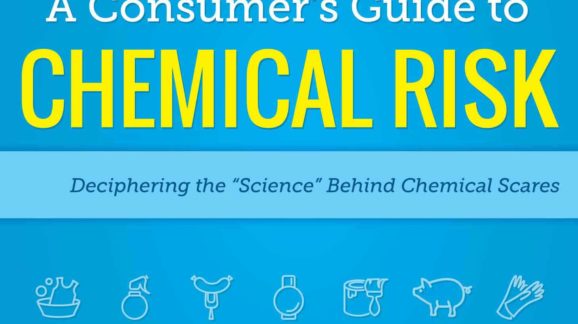A Consumer’s Guide to Chemical Risk
Deciphering the Science Behind Chemical Scares

Full Document Available in PDF
A constant barrage of news headlines suggests that synthetic chemicals—even some naturally occurring ones—are responsible for nearly every public health problem imaginable, sowing fear and confusion among consumers. This publication is designed to reduce both the confusion and fears about chemicals by providing consumers with some insights on the science and the politics behind the headlines.
When it comes to studies attempting to link chemicals and health ailments, the absolute risks are largely theoretical and generally too low to measure. In fact, many of the alarmist new stories report on studies where the findings are very weak and often inappropriate for drawing any conclusions. Accordingly, rather than panic about scary headlines, consumers can seek answers to some fundamental questions such as:
- Is the association strong and statistically significant? Most of the studies cited in the news are merely statistical analyses that assess whether two factors occur at the same time. They do not prove cause-and-effect relationships, which can only be inferred when the association is very strong. Accordingly, if researchers report a “weak” or “suggestive” association, consumers should be suspicious of the claims.
- Is the sample any good? Ideally, a randomly selected, large sample of a population provides the best chance of good data, but locating and developing such samples is difficult and expensive. Accordingly, researchers often work with less-than-ideal samples and existing databases that offer imperfect data, or both. Accordingly, a study with 1,000 randomly selected subjects is more reliable than one with 100 subjects cherry-picked from a database.
- Are there serious confounding factors? The possibility that a factor other than the two variables in question is responsible for the result is always present. While scientists attempt to apply “controls” in studies in an effort to negate the impact of such confounding factors, it does not always work. Consumers should be suspicious when there are other factors that more likely contributed the result.
- What is the potential for recall bias among study participants? Some studies require interviewing subjects about their personal behavior, sometimes expecting them to recall chemical exposures dating back decades. The subject’s failure to recall the facts accurately can so undermine the validity of the data that the final study results are completely off the mark. Consumers should be wary of studies that rely on this type of subjective data collection.
- Does the language used by researchers suggest bias? Good researchers will strive to keep their biases in check, while still working toward finding something interesting. Yet, others add “spin” to weak and meaningless “findings” to garner publication and media interest—and more funding. For example, researchers trying to prove that trace chemicals can make us fat have captured headlines by labeling these chemicals as “obesogens.” Their science may be weak, but their marketing it this way garners lots of media coverage.
- Is the study relevant to humans? Tests on rodents involve administering massive amounts of chemicals to animals bred to be highly susceptible to cancer, and many form tumors as a result. Despite what headlines may suggest, such tests are not particularly relevant to risks associated with human exposures to trace levels of chemicals.
- Is the exposure significant enough to matter? Many substances that are helpful or benign at low levels can sicken or kill at high levels. Accordingly, if the study involved high exposures, consumers should question whether it is relevant to trace exposures through consumer products.
- Is the study peer-reviewed and published? Peer review is designed for an industry to self-regulate to reduce fraud and poor quality research. While it alone is not sufficient to assure a study is completely sound, consumers should be very skeptical of claims from studies that have not undergone peer review.
- Can other researchers reproduce the study results and have they done so? Science is a long process of discovery that brings us closer to an answer as an issue is examined time and again. Part of that process involves repeating specific studies to see whether different scientists or teams of scientists can reproduce results of their peers’ or even their own research. If data are unavailable or other researchers have not been able to reproduce the result, the study is less compelling and may be discredited.
In addition, consumers should be alerted to sensationalist hype by simply playing attention to certain terms used by those in the alarmist trade. For example, many times, activists will call for bans or hype risks about products that contain trace amounts of chemicals that are “classified carcinogens.” Government and scientific bodies around the world have developed such classification systems to indicate that at some exposure level and under some circumstance a chemical might increase cancer risk. Such listings do not mean that the chemicals cause cancer in humans exposed to trace amounts found in consumer products.
Similarly, some environmental activists raise fears about chemicals by claiming that most cancers are related to “environmental factors.” It is true that cancer researchers blame “environmental factors” as causing most cancers, but they define these factors as anything but genetics. According to the landmark research conducted by Richard Doll and Richard Peto, environmental factors include tobacco, dietary choices, infections, natural radiation, and reproductive behavior. Trace chemicals in consumer products are not a demonstrated cancer source.
Consumers need not panic about any particular study, nor completely dismiss studies because of uncertainty. Rather, we should focus less on any single study and more on what the larger body of research indicates about a particular issue. In addition, we should remain wary of headlines and anyone claiming to have changed the nature of the debate with a single study.